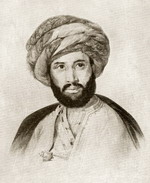
Rifāʽa al-Ṭahṭāwī is the founder of the modern intellectual nahḍa (‘resurgence’, ‘renaissance’) at the beginning of the 19th century, the inspiration for which he drew from his shaykh Ḥasan al-‘Aṭṭār. Al-Ṭahṭāwī subsequently went on to make his own contributions to the founding of the structures for this resurgence. Had it not been for his courage in addressing issues that were considered taboo in his time, the door would not have been opened for subsequent pioneers of the nahḍa to source and establish other foundations for the raising and liberalisation of thought.
AL-ṬAHṬĀWĪ’S THOUGHT was highly encyclopedic, but what distinguishes it most is two terms that are in their essence more elevated than their general use implies, namely: ‘modernity’ and ‘modernisation’. These two concepts derive their roots from al-Ṭahṭāwī’s own life, since he derived them from the words of his teacher, Ḥasan al-‘Aṭṭār:
The conditions of our country must change and undergo renewal from sources of knowledge that are not available within it.
The conditions to be changed meant the modernization and urbanization of the social structure in general. As for the renewal of knowledge this referred to modern concepts of thought, values, morals and behaviour in a broad sense. It meant a renaissance upheaval, a new concept of time and history as embodied in Shaykh al-Ṭahṭāwī’s own experience.
This experience raised these twin concepts, modernity and modernization, beyond the level of ancient concepts of time and history, concepts which were enclosed within a cyclical or Salafist retrospective vision. Such an objective vision of time and history may have been deepened by his his physical journey to another, more sophisticated and advanced vision of time and history which he encountered in France. His journey contributed to sharpening his acumen in the field of rational thought and allowed him to shed more and more of the Salafist limitations and restrictions, and attain to the horizons of a forward-thinking rational vision, to a horizon of progress, urbanization, and renaissance.
His journey contributed to sharpening his acumen in the field of rational thought
In this way, al-Ṭahṭāwī was reconstructing the historical map of Mankind on three levels. The first was the level of savage nomads, the second the level of rude barbarians, and the third the level of culture, wit, civilization, urbanization and prosperity. The question that we must ask here before delving more deeply into the thought of al-Ṭahṭāwī, is whether after more than a hundred years his thought is still fresh enough and practicable for societies today. The answer is yes, due to the relapse of the renaissance thought that al-Ṭahṭāwī initiated. For he spoke about the modalities of education for male and female students alike in his 800-page work Al-Murshid al-Amīn lil-Banāt wal-Banīn (‘The Trustworthy Guide for Girls and Boys’). This work was very popular in its time and the first edition quickly ran out. It was reprinted two years following the death of its author in 1875. This book is classified as the first book on education in contemporary Arabic literature.
But how much have we been able to raise the standard of our educational aptitude within our schools and our social environment and embrace the ideas and issues that Rifāʽa al-Ṭahṭāwī pointed to more than a hundred years ago? The answer is – nothing in fact, bar a few elements and some very basic ideas here and there.
Modernity, in essence, means breaking out of the circle of stagnation, obscurantism, feudalism, and authoritarian tyranny, the affirmation of the freedom of the human individual, and of social, intellectual, and creative freedom, along with its transformative power both in nature and in society. Modernity and modernization, as generally understood, are not the exclusive preserve of the present, but are historical indicators expressing objective evaluations that transcend each other without canceling out the nature of modernism.
Here we might pause a little and ask ourselves to what extent can Rifāʽa al-Ṭahṭāwī’s be considered a modernist call with a modernizing orientation? Most studies on al-Ṭahṭāwī consider him to be a syncretistic, reconciliatory thinker who sought to build bridges between Sharīʻa and contemporary society, with the Sharīʻa for him being virtually the source and starting point. This is the view of the distinguished poet Adonis, who says that:
Al-Tahtawi looks at civilization from the position of absolute and a priori faith in the Islamic religion and its validity, separating between science and religion, and accordingly he sees that knowledge of the machinery by which life and urbanization are improved and civilization perfected does not, in general, contradict the faith. On the contrary, he insists on the need for this knowledge and that Muslims are to seek it and strive for it. And if non-Muslims – the infidels – are the ones that possess it, one must in response weed out all thinking that corrupts the faith and reject it as required.
Therefore, Adonis maintains, on the level of improving life, there is a possibility for a reconciliation between religion and science, but a complete separation between these on the level of conceiving God, existence and the Hereafter. Adonis concludes from this that
we do not see anything new in al-Ṭahṭāwī that theoretically adds to the syncretistic, reconciling position that the ancient Arab philosophers, Ibn Rushd especially, arrived at and by which they emphasized the unity between faith and philosophy. Ibn Rushd, however, was more profound and more penetrative and radical in his rational analysis.
Adonis then concludes with a general judgment on the entire period of the Arab resurgence in the 19th century, arguing that al-Ṭahṭāwī represented ‘a model of the nahḍa era that prevailed in modern Arab life at the level of the system and its institutions’.
Some have raised several objections to Adonis’ claims concerning al-Ṭahṭāwī:
Firstly: the idea that al-Ṭahṭāwī confined himself to calling for knowledge of machines is incorrect since he actually called for knowledge of what lay behind the manufacture of machines in terms of the theoretical sciences, even those theoretical sciences that called into question religious learning.
What he did do was take some of the prophetic hadiths as a basis calling for, and even obligating, the necessity of this knowledge. He thus did not separate between science and religion, even if he made a distinction between some ‘scientific theoretical’ and ‘religious’ facts, as a result of which he adopted a contradictory stance of admiration, vilification and rejection, but not a stance of complete separation. In this context we may recall an interesting verse of al-Ṭahṭāwī in this regard:
Is there any such place as Paris?
Where no suns of knowledge set,
And no dawn to infidelity’s night?
(Odd indeed, though ‘tis their right).
In similar vein he observed that the French are among those who consider beautification or disfigurement to be in the mind (he may be reminding us here of the position taken by the Muʽtazila)[1] –
I say here that they deny the possibility that natural laws can be broken or that nature can be contradicted in the first place, and that religions only came to guide people to do good and avoid its opposite, that the world is everlasting and that the diversity of people and the level of their manners and charm fulfils the role of religions.

Suggested Reading
Secondly: it is not true that al-Ṭahṭāwī did not add anything new to the syncretistic, reconciliatory position held by the ancient Muslim philosophers, especially Ibn Rushd, for the following reasons:
a) The ancient Muslim philosophers, Ibn Rushd included, stood at the frontiers of pure theoretical thought in their attempts to reconcile Sharīʻa with science [lit. ‘wisdom’]. Al-Ṭahṭāwī was not undertaking this intellectual task since he was not a philosopher; his was a practical mode of thinking, that of a progressive harbinger of democracy, and if we do find this naturally absent or did not go into any philosophical depth in this, he nevertheless made reference to this on more than one occasion;
b) Al-Ṭahṭāwī went beyond this theoretical mode of thinking and onto the practical and the applied, that is, towards changing patterns of life according to the dictates of al-maṣlaḥa (‘public interest’)[2] and in line with its jurisprudence, especially as expounded by Ibn al-Qayyim al-Jawziyya, and in line with what modern scientific thought has attained irrespective of principles that do not literally agree with the divine law;
c) The essence of al-Ṭahṭāwī’s thought and the essence of his call is not one of proving that there is no conflict between scientific thought and religion or of adhering to religion as such. In essence he was not calling for a reconciliation but, as far as I see it, for a democratic rationality in the realm of faith. Perhaps his call for political democracy implied the separation of state and faith or the freedom of political choice without commitment to a specific religion, on the basis of the principle of public interest or, otherwise put – that the intellectual, practical, civilization aspect of his thought was its distinguishing feature. Or to put it even more clearly and succinctly – that he strove to make faith subordinate to the requirements of the age and even develop it in a way that accords with the demands of urbanization and civilization. Furthermore, he was an intellectual thinker who viewed religion from the angle of the necessity for urbanization and civilization and did not view urbanization and civilization from the angle of religion. I might even venture to say that he did not view religion as a fundamental standard for civilization and urbanization, but rather the other way round: he saw civilization and urbanization as a fundamental basis for viewing religion.
d) It is therefore not correct to consider al-Ṭahṭāwī a model ‘in the sense of Saint-Simon’, as Professor Mahmoud Amin Al-Alam put it[3] , some model for renaissance thought based on the separation between religion and science, or on the contradiction between them or their reconciliation from the point of view of the practical and industrial side alone. This is because the Arab Islamic nahḍa era was a combination of more than one intellectual ingredient. Alongside this rational, democratic mode of thinking, expounded in al-Ṭahṭāwī’s writings, there was also a puritanical Wahhābī mode of thought, one which held that ‘our present can only be reformed by what reformed our past.’ There was also a non-religious mode of thinking represented by the thought of Shiblī Shumayyil.[4] There was thus no single mode of nahḍawī thought.
[1] See Glossary.
[2] Maṣlaḥa is a key concept of Islamic law, referring to what serves the broader benefit or interest (maṣlaḥa) of the community. The directly indicated maṣlaḥa in the Text is know as maṣlaḥa muʽtabara (a ‘validated maṣlaḥa’) and where there is no indication at all, it is maṣlaḥa mursala an ‘unrestricted’ maṣlaḥa’, one that is not defined by the established rules of the Sharīʻa and therefore to be established by the jurist himself. (Ed.)
[3] Henri de Saint-Simon (1760-1825) was a French political, economic and socialist theorist and businessman whose thought had a substantial influence on politics, economics, sociology and the philosophy of science. He stressed the need for recognition of the merit of the individual and the need for hierarchy of merit in society and in the economy such as society having hierarchical merit-based organizations of managers and scientists to be the decision-makers in government. His Enlightenment valorization of scientific knowledge inspired many social and political reformers. (Ed.)
[4] Shiblī Shumayyil (1850–1917) was a Lebanese doctor who published on topics such as Islamic socialism and social Darwinism, arguing that man relied on cooperation to progress. He was a key contributor to influential scientific journals of his time. (Ed.)
Main image: Old 19th century print of Boulevard Montmartre, Paris.


